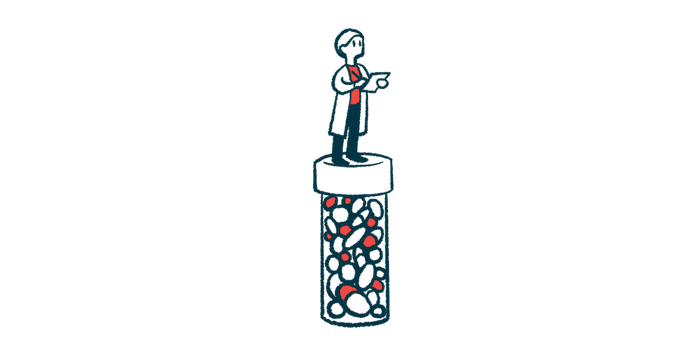Opioid use high among AS patients, before and after diagnosis: Analysis
Scientists call for more research to support move to targeted therapies
Written by |

Opioid use is highly prevalent among people in the U.S. with ankylosing spondylitis (AS), both before and after diagnosis, according to a medical claims database analysis.
Similar results also were found among patients with other types of inflammatory diseases affecting the joints, such as psoriatic arthritis and rheumatoid arthritis, according to the researchers, who noted that such drugs are “generally not appropriate for the chronic treatment of these conditions and are not recommended by treatment guidelines.”
“Opioids are neither disease modifying, nor a targeted/recommended treatment for chronic autoimmune diseases. In addition to their association with significant economic costs, opioids are potentially hazardous and are not better than alternative treatments with superior safety profiles,” the researchers wrote.
“The reasons behind opioid prescribing patterns should be explored further to support movement to targeted therapies,” the team added.
Their study, “Opioid use surrounding diagnosis and follow-up in patients with ankylosing spondylitis, psoriatic arthritis, and rheumatoid arthritis: Results from US claims databases,” was published in Clinical Rheumatology.
Opioid use not recommended for AS by US treatment guidelines
Ankylosing spondylitis, psoriatic arthritis, and rheumatoid arthritis — known for short as AS, PsA, and RA, respectively — are three distinct chronic inflammatory diseases that affect the joints and the skeleton, causing considerable pain and disability.
AS mainly affects the spine and sacroiliac joints, where the base of the spine meets the pelvis. Rheumatoid arthritis primarily involves the small joints of the hands and feet, which tend to affect both sides of the body equally. Psoriatic arthritis also impacts the joints of the hands and feet but is associated with psoriasis, marked by scaly, dry, or itchy patches of skin.
Treatment for all three conditions typically includes medicines that reduce inflammation and pain, including nonsteroidal anti-inflammatory drugs, known as NSAIDs, and biologic disease-modifying antirheumatic drugs, called bDMARDs.
Opioids are a family of drugs that work in the brain to produce a variety of effects, including pain relief. However, these drugs generally are considered inappropriate as treatments for these chronic inflammatory conditions and, as such, are not recommended by U.S. treatment guidelines. In fact, opioid use in AS has been associated with worse patient-reported outcomes.
Several studies have found concerning levels of opioid use among patients with rheumatic diseases. Still, exposure to opioids before diagnosis and the patterns of opioid use surrounding diagnosis are not well characterized, according to scientists at UCB Pharma. The Belgium-based company is the developer of Bimzelx (bimekizumab), approved in Europe to treat AS.
“It is important to assess opioid use surrounding diagnosis of these diseases to gain a better understanding of the temporal trends and associated risk factors,” the scientists wrote.
Data were sourced from the U.S. IBM MarketScan Commercial Claims and Encounters (CCAE), a database of insurance claims from people with employer-sponsored insurance, and Medicaid. For each newly diagnosed patient with a rheumatic disease, three sex- and age-matched patients without these diseases were selected as a comparison.
CCAE data included 5,769 patients with AS, 10,880 with PsA, and 91,722 with RA. Overall, the mean age of the AS patients was 49.2, and a little more than half (54.6%) were men. At the time of the first insurance claim (baseline), those with rheumatic diseases had higher rates of depression, anxiety, fatigue, and fibromyalgia — generalized pain and fatigue, among other complications — than comparators.
During the baseline period, defined as 12 months before a claim, nearly twice as many AS patients used any opioid than comparators (42.4% vs. 24.2%). Opioid abuse was noted in 1% of cases.
Over follow-up, chronic opioid use, defined as a cumulative supply for at least 90 days, was 3.82 times higher for AS patients than comparators. Similar findings were observed for long-term opioid use, which was defined as at least one opioid claim in three or more quarters (three-month periods) during follow-up.
Data highlight need for greater adherence to therapy guidelines
More than half of AS patients (63.6%) had at least one claim for a U.S. guideline-recommended, or appropriate, therapy during follow-up. Opioids as a single therapy (monotherapy) remained steady, between 12.5% and 13.8%, while 13.2%-16.3% of AS patients received opioids in combination with appropriate treatment.
Opioid use, chronic opioid use, and long-term opioid use were similar between men and women with AS over follow-up. AS patients who visited a rheumatologist had less exposure to opioids and more exposure to bDMARD therapies. Opioid use as a monotherapy was lower in patients who saw a rheumatologist.
The Medicaid population included 337 AS patients, 530 with psoriatic arthritis, and 7,369 with rheumatoid arthritis. Baseline rates of depression, anxiety, and fatigue were again higher in the disease groups than comparators.
Similar to the CCAE population, more AS patients with Medicaid used opioids during the baseline period than comparators (65.9% vs. 48.3%). The researchers noted that 4.7% of AS patients were flagged for opioid abuse before diagnosis. During follow-up, the rate of opioid use was 2.21 higher, and long-term opioid use was 2.05 higher, among Medicaid AS patients than comparators.
These findings indicate that opioid use for management of pain associated with AS, PsA, or RA is highly prevalent in the US and continues after diagnosis.
NSAID use was relatively stable among these patients with AS after diagnosis. Like with CCAE, more than half of AS patients (69.4%) had at least one claim for appropriate therapy during follow-up. Opioids used in combination with appropriate treatment were more common than appropriate therapy alone, with the frequency of opioid monotherapy ranging between 24.9%-33.2% over quarterly periods.
“These findings indicate that opioid use for management of pain associated with AS, PsA, or RA is highly prevalent in the US and continues after diagnosis,” the scientists concluded, noting that “these considerations advocate a different approach to treatment of pain.”
“Better diagnosis, education, and adherence to guidelines may lead to improved treatment strategies and reduced use of chronic opioids to manage pain in rheumatic disease,” they wrote.






